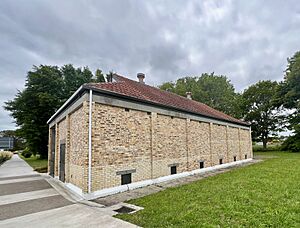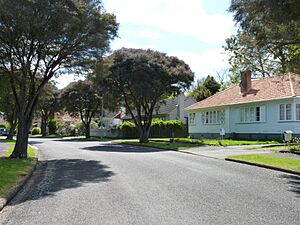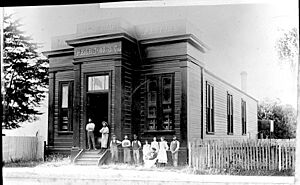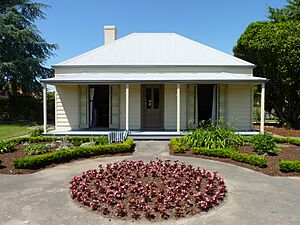Hamilton East, New Zealand facts for kids
Quick facts for kids
Hamilton East
|
|
|---|---|
|
Suburb
|
|
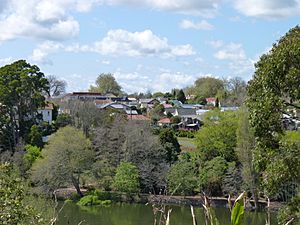
Hamilton East, viewed from Hamilton West.
|
|
| Country | New Zealand |
| Local authority | Hamilton, New Zealand |
| Electoral ward | East Ward |
| Established | 1877 |
| Area | |
| • Land | 472 ha (1,166 acre) |
| Population
(June 2023)
|
|
| • Total | 14,990 |
|
|
||
Hamilton East is a lively suburb in the city of Hamilton, located in New Zealand. It's known for its main shopping area along Grey Street. Many homes here are beautiful old villas and bungalows built in the early 1900s.
Contents
- Hamilton East: A Look at Its Past
- Exploring Hamilton East's Attractions
- Hamilton Gardens: A World of Gardens
- Hayes Paddock: A Special Neighborhood
- Institute de Notre Dames des Missions: A Historic Convent
- Cathedral of the Blessed Virgin Mary: A Modern Church
- Memorial Park: Honoring Heroes
- Parana Park: A Green Space for Fun
- Steele Park: A Historic Gathering Place
- Galloway Park: A Sports Hub
- Greenslade House: A Grand Old Home
- Beale Cottage: Hamilton's Oldest House
- Nga Uri o Hinetuparimaunga: A Stone Sculpture
- Former Waikato County Council Office: A Building's Journey
- Hamilton East: People and Numbers
- Education in Hamilton East
Hamilton East: A Look at Its Past
Hamilton East is one of Hamilton's oldest suburbs. From the 1870s until the mid-1900s, it was sometimes called 'Irishtown'. This was because many of the soldiers who settled here were Irish. Also, many other New Zealand Catholics came to live near the Catholic Church and convent.
The town of Hamilton East joined with Hamilton West in 1877. Many streets were named after important people from the New Zealand Wars. These included Governor George Grey and Maori chief Te Awaitaia. He was also known as William Naylor or Wiremu Neera after he became a Christian.
You can still see how the town was planned. Steele Park was designed like a village green. English trees were planted along Grey Street. Hamilton East is one of the few suburbs in Hamilton with a street grid plan, like a checkerboard.
Many parks in Hamilton East, including Hamilton Gardens, are part of the original Hamilton Town Belt. This green space runs along the eastern and southern edges of Hamilton East.
Just north of the Gardens, Flynn Park was home to an ammunition factory from 1942 to 1946. It's the southernmost park in the original Town Belt. It's also near the Wairere Drive extension towards Peacocke.
The first Royal Hotel opened in July 1865. It was on the corner of Grey and Cook Streets. The hotel burned down in 1894 but was rebuilt that same year. Many early meetings, including those for the local road board, were held there. The Royal Hotel stood until 1971. Today, a tavern and liquor store are on that corner.
In 2000, the suburb grew bigger. It took over part of the former Ruakura Experimental Farm. This added 321 new houses at Sherwood Park. The streets in this area have names related to Sherwood Forest. People even campaigned to save a line of redwood trees from the development.
Exploring Hamilton East's Attractions
Hamilton Gardens: A World of Gardens
Hamilton Gardens is a huge public park, covering 58 hectares. It's located right along the Waikato River. This park is the most popular place to visit in the region. About 1.3 million people visit each year, and almost half are tourists!
The gardens have been built in stages since the 1980s. They feature different collections like paradise gardens, productive gardens, and landscape gardens. The amazing paradise collection includes a Chinese scholar's garden, an English flower garden, a Japanese garden, an American modernist garden, an Italian Renaissance garden, and an Indian char bagh garden.
Hayes Paddock: A Special Neighborhood
Hayes Paddock is a unique area in Hamilton East. It was built between 1939 and 1945. The design followed the ideas of the First Labour Government and the Garden City Movement. This means it has curved streets, open gardens, and lots of walkways and green spaces.
Hayes Paddock has over 200 classic state houses. These homes are built along seven streets. Most of these streets are named after New Zealand governors general. These governors general were important leaders of their time. Macfarlane Street is the only one not named after a governor general. It's named after James MacFarlane, a businessman. The area itself was named after William Hayes, who farmed there from 1903 to 1925.
- Viscount Sir Charles Bathurst Bledisloe was Governor General from 1930–1935. His street is Bledisloe Terrace.
- Sir Charles Fergusson was Governor General from 1924–1930. His street is Fergusson Street.
- Sir George Monckton-Arundell, 8th Viscount Galway was Governor General from 1935–1941. His street is Galway Avenue.
- Viscount Sir John Rushworth Jellicoe was Governor General from 1920–1924. His street is Jellicoe Drive.
- Sir William Lee Plunket was Governor General from 1904–1910. His street is Plunket Terrace.
- Sir William Hillier Onslow was Governor General from 1889–1892. His street is Onslow Street.
Thanks to local heritage groups, Hayes Paddock is now protected. This helps keep its special history safe.
Graham Island: A Tiny River Island
Graham Island is a small island, about 0.2 hectares, in the river. It's separated from the main riverbank by about 5 meters of shallow water. The island rises about 4 meters above the river. It's mostly covered in raspberry plants. The main trees are alder and silver and golden wattle. Long ago, a Pā (a Māori fortified village) called Te Moutere O Koipikau once stood on the island.
Wellington Street Beach: A Local Favorite
A beach was part of the plan for this area in 1945. In 2013, it was even voted one of New Zealand's best beaches!
Institute de Notre Dames des Missions: A Historic Convent
The Institute de Notre Dames des Missions was a convent built in the Romanesque style on Clyde Street. Most of the building was taken down in 2017. However, the chapel was saved and restored. It is now a Category 2 listed building, meaning it's a place of historical importance.
Cathedral of the Blessed Virgin Mary: A Modern Church
The modern Cathedral of the Blessed Virgin Mary was opened in 1980. It was updated in 2008. It is the main church for the Hamilton Catholic Diocese.
Memorial Park: Honoring Heroes
Hamilton's first soldiers landed at this spot in 1864. The park and its cenotaph (a monument for those who died in a war) were created to remember soldiers from the First World War. This area was once called Kowhai Bank. The park also has memorials for the Second World War and a Spitfire air-force memorial. In 2017, a life-size bronze statue of a war horse was unveiled. It remembers the horses that fought for New Zealand in the First World War.
Paddle Steamer Rangiriri: A River Relic
On the riverbank, you can see the remains of the paddle steamer Rangiriri. This boat was built in Sydney and put together in Port Waikato. The first soldiers landed from the Rangiriri in Hamilton on August 24, 1864. It ran aground in 1889. It was lifted from the riverbed in 1981 and restored in 2010. The Rangiriri was about 27 meters long and 6 meters wide.
River Cruises: Exploring by Boat
From 1985 to 2009, the MV Waipa Delta offered boat trips from the park. A smaller boat replaced it for a while. Then, the boat dock at the park was removed in 2013. Another boat, the Cynthia Dew, ran river cruises from 2012 until 2022.
Parana Park: A Green Space for Fun
Parana Park is about 1.2 hectares. It's like an extension of Memorial Park to the north. George Parr left this park to the city in his will in 1929. He was the son of the 1893 Mayor. In 1936, a paddling pool and playground were built. They even brought in wallabies and a possum for a time. The playground was rebuilt in 2012. The park has several special trees and structures. In Gibbons Creek, a barrier was removed, and three fish passes were built. These help fish move past obstacles in the creek.
Steele Park: A Historic Gathering Place
At the center of Hamilton East is Steele Park. It's named after a soldier, William Steele. It was first called Sydney Square, after the city in New South Wales where many soldiers joined up. The oak trees around the park were planted in 1889. This was 25 years after the soldiers arrived. In the past, it was a place for settlers to gather. Today, it's still an important spot for sports, cultural events, and social gatherings.
Oddfellows Hall: A Building with Many Lives
The Loyal Hamilton Lodge of the Independent Order of Oddfellows building was built in 1874. It's on the edge of Steele Park. It is now a Historic Place Category 2 building and houses a bar. From about 1884, the family who built it used it as a factory. They made Pearson's sandsoap. They even opened a factory in Sydney in 1892.
Galloway Park: A Sports Hub
Galloway Park was once a fort. Now, it's a busy sports park. It's used for different sports all year round. In summer, it's mainly for cricket. In winter, it's mostly used for soccer.
Greenslade House: A Grand Old Home
Greenslade House is a unique Edwardian house with a turret. It's located at 1 Wellington Street. It was built between 1910 and 1912 for Henry Greenslade. He was an important Hamilton businessman and a Member of Parliament. The architect, John W Warren, also helped design the Waikato Hospital. The Pearson family, who made sandsoap, lived in the house from 1934. It's still a private home today. It was listed as a Historic Place Category 1 building in 1989.
Beale Cottage: Hamilton's Oldest House
The tiny cottage on the corner of Beale and Grey Streets is the oldest house still standing in Hamilton. It's named after Bernard Charles Beale, who was the 4th Mayor of Hamilton. He designed and built this simple cottage in 1872. He used local kauri and kahikatea wood. Soon after, he added more rooms. One room in the house was even used as a doctor's surgery.
Nga Uri o Hinetuparimaunga: A Stone Sculpture
Located at the entrance to Hamilton Gardens, Nga Uri o Hinetuparimaunga is a beautiful sculpture. It was created by two famous artists, Chris Booth and Diggeress Te Kanawa. Their design was chosen in a competition. This sculpture is made of woven Hinuera stone. It celebrates natural creative processes.
Former Waikato County Council Office: A Building's Journey
The old Waikato County Council office is at 455 Grey Street. It's on the corner of Clyde Street and opened in 1910. This building hasn't changed much and is now used by a travel agent. It's protected as a historic building. New offices were built behind it in 1971. The old building was then used by the Ministry of Agriculture. After 1989, the new building was used by the Waikato District Council and then by Hill Laboratories. Since 2020, the new building has been renovated into apartments.
Hamilton East: People and Numbers
Hamilton East covers about 4.72 square kilometers. It has an estimated population of 14990 people as of June 2023, . This means there are about 3176 people per square kilometer.
| Historical population | ||
|---|---|---|
| Year | Pop. | ±% p.a. |
| 2006 | 10,713 | — |
| 2013 | 11,607 | +1.15% |
| 2018 | 12,996 | +2.29% |
In 2018, Hamilton East had a population of 12,996 people. This was an increase of 12.0% since 2013. There were 4,674 households. There were slightly more females than males. About 16.7% of people were under 15 years old. Many residents, about 39.1%, were aged 15 to 29.
The people living in Hamilton East come from many backgrounds. About 60.6% are European/Pākehā. Around 20.7% are Māori. About 7.2% are Pacific peoples. And 20.9% are Asian. About 32.9% of people were born overseas.
When it comes to religion, 45.9% said they had no religion. About 34.1% were Christian. Other religions included Hindu, Muslim, and Buddhist.
Many people in Hamilton East have gone to university. About 28.8% of people aged 15 or older had a bachelor's degree or higher. About 41.8% of people aged 15 or older worked full-time.
Education in Hamilton East
Hamilton East has several schools for different age groups.
- Hamilton Boys' High School is a secondary school for boys (years 9–13). It opened in 1955. It has about 2,238 students.
- Hamilton East School is a primary school for both boys and girls (years 1–6). It opened in 1872 and is the oldest school in Hamilton still on its original site. It has about 484 students.
- Sacred Heart Girls' College is a Catholic secondary school for girls (years 9–13). It was started in 1884. It has about 950 students.
- Marian Catholic School is a Catholic primary school for both boys and girls (years 1–8). It was formed in 1989. It has about 581 students.
All student numbers are as of February 2024. .



